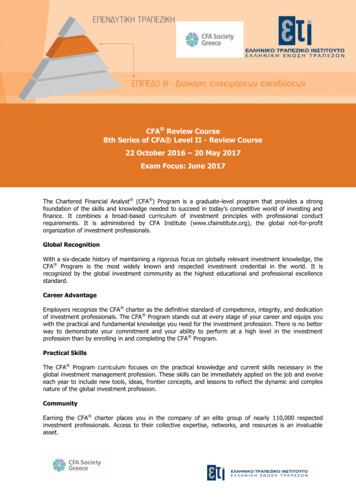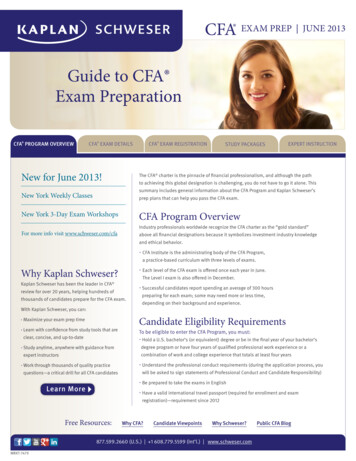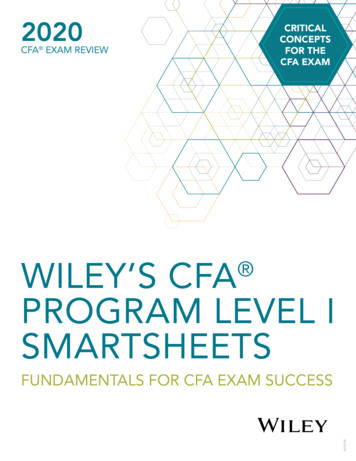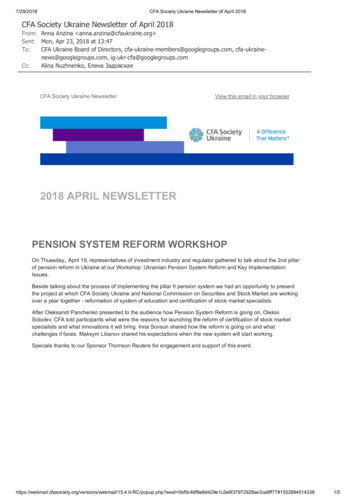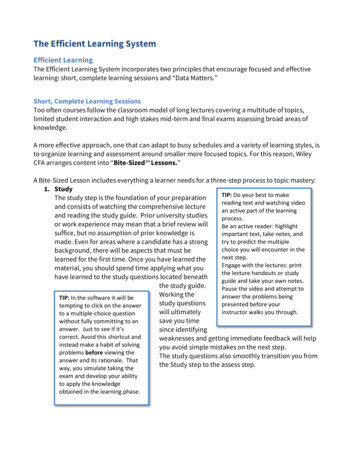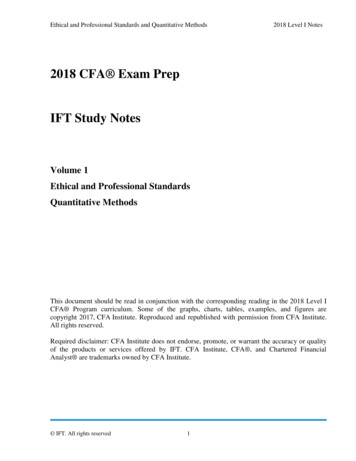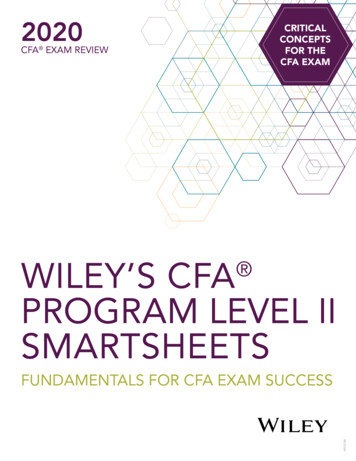
Transcription
2020CRITICALCONCEPTSFOR THECFA EXAMCFA EXAM REVIEWWILEY’S CFAPROGRAM LEVEL IISMARTSHEETS FUNDAMENTALS FOR CFA EXAM SUCCESSWCID184
Wiley’s CFA Program Exam Review ETHICAL ANDPROFESSIONAL STANDARDSSTANDARDS OF PROFESSIONAL CONDUCTI.ProfessionalismA. Knowledge of the LawB. Independence and ObjectivityC. MisrepresentationD. MisconductII. Integrity of Capital MarketsA. Material Nonpublic InformationB. Market ManipulationIII. Duties to ClientsA. Loyalty, Prudence, and CareB. Fair DealingC. SuitabilityD. Performance PresentationE. Preservation of ConfidentialityIV. Duties to EmployersA. LoyaltyB. Additional Compensation ArrangementsC. Responsibilities of SupervisorsV. Investment Analysis, Recommendations, and ActionsA. Diligence and Reasonable BasisB. Communication with Clients and ProspectiveClientsC. Record RetentionVI. Conflicts of InterestsA. Disclosure of ConflictsB. Priority of TransactionsC. Referral FeesVII. Responsibilities as a CFA Institute Member or CFACandidateA. Conduct as Participants in CFA Institute ProgramsB. Reference to CFA Institute, the CFA Designation,and the CFA Programt-stat Estimated regression coefficientt Hypothesized value of regression coefficientStandard error of regression coefficient p-value: lowest level of significance at which we canreject the null hypothesis that the population value ofthe regression coefficient is zero in a two-tailed test (thesmaller the p-value, the weaker the case for the nullhypothesis) ANOVA table for testing whether all the slope coefficientsare simultaneously equal to zero (use a one-tailed F-testand reject null hypothesis if F-statistic Fcrit)Source ofVariationDegrees ofFreedomSum ofSquaresMean Sumof SquaresRegressionkRSSMSR RSS / kMSE SSE /n (k 1)Residualn (k 1)SSETotaln 1SSTF -stat FMSR/MSESignificancep‐valueRSS / kMSR MSE SSE /[n ( k 1))]] Standard error of the estimate (SEE) MSE using MSEfrom the ANOVA table Coefficient of determination (higher R2 indicates a higherproportion of the total variation in dependent variableexplained by the independent variables)R2 Total variatioarariation Unexplained variatioarariation SST SSE RSS variationvaSSTSSTTotal vari Adjusted R2n 1 AdAdjustedR 2 R 2 1 (1 R 2 ) n k 1 VIOLATIONS OF REGRESSIONASSUMPTIONS Heteroskedascity: variance of error term is not constant Unconditional: heteroskedasticity is not related toMULTIPLE REGRESSION (2 OR MOREINDEPENDENT VARIABLES)the independent variables (does not affect statisticalinference). Conditional: heteroskedasticity is correlated withthe independent variables (causes F-test for overallsignificance of the regression and t-test for thesignificance of each regression coefficient to becomeunreliable). Serial correlation: regression errors are correlatedacross observations (could be positive or negative andhas same effect on statistical inference as conditionalheteroskedasticity) Multicollinearity: two or more independent variables(or combinations of independent variables) are highlycorrelated Makes regression coefficients inaccurate and t-testfor the significance of each regression coefficientunreliable. Difficult to isolate the impact of each independentvariable on the dependent variable. Model specification errors Misspecified functional form (omitting importantvariables; variables may need to be transformed;pooling data incorrectly). Time-series misspecification (including laggeddependent variables as independent variables inregressions when there is serial correlation of errors;including an independent variable that is a functionof the dependent variable; measuring independentvariables with error; nonstationarity). Confidence interval for regression coefficients: use n –TIME SERIES ANALYSISQUANTITATIVE METHODSLINEAR REGRESSION(1 INDEPENDENT VARIABLE) Standard error of the estimate (smaller SEE indicatesbetter fit of regression model) n2 ˆ ˆ (Yi b0 b1 X i ) SEE i 1n 2 1/2 n2 (εˆ i ) i 1 n 2 1/2 Prediction interval around the predicted value of thedependent variable 1 ( X X)2 s 2f s 2 1 2 n (n 1)sx Yˆ tc s f(k 1) degrees of freedombˆ j (tc sbˆ )jestimated regression coefficientt ((critical t -value)(coefficient standardtanda error)tandard Hypothesis test on each regression coefficient: use n –(k 1) degrees of freedom Linear trend model: predicts that the dependent variablegrows by a constant amount in each periodln yt b0 b1t εt , t 11,21,2,,2,, . . . , T Autoregressive (AR) time series model: uses past valuesof the dependent variable to predict its current value First-order AR modelxt b0 b1 xt 1 εt AR model must be covariance stationary and specifiedsuch that the error terms do not exhibit serialcorrelation and heteroskedasticity in order to be usedfor statistical inference. t-test for serial (auto) correlation of the errorterms (model is correctly specified if all the errorautocorrelations are not significantly different from 0)t-stat Mean-reverting level of AR(1) modelMean revertinver g level xt vertinvariable exhibits exponential growthb01 b1 Random walk is a special AR(1) model that is notcovariance stationary (undefined mean reverting level)xt xt 1 εt , E(εt ) 0, E(εt2 ) σ 2 , E(εt ε s ) 0 if t s First difference of a random walk in order to make itcovariance stationary (mean reverting level of 0)yt xt xt 1 xt 1 εt xt 1 εt , E(εt ) 0, E(εt2 ) σ 2 , E(εt ε s ) 0 for t s AR(1) model has a unit root if the slope coefficientequals 1, e.g., a random walk. Dickey-Fuller test indicates that a time series has a unitroot if the null hypothesis is not rejected. Seasonality in AR models: the seasonal autocorrelationof the error term will be significantly different from0 (can be solved by introducing a seasonal lag in themodel). ARCH models: used to determine whether the varianceof the error in one period depends on the varianceof the error in previous periods (if ARCH errors arefound, use generalized least squares to correct forheteroskedasticity) Regression with two time series: use the Dickey-Fullertest to determine whether the independent variable andthe dependent variable have a unit root If neither of the time series has a unit root, linearregression can be used to test the relationshipsbetween the two time series. If either of them has a unit root, linear regressioncannot be used as results may be spurious. If both of them have unit roots and if they arecointegrated, the regression coefficients and standarderrors will be consistent and they can be used toconduct hypothesis tests.MACHINE LEARNING Supervised ML algorithms include: Penalized regression are models with a large number yt b0 b1t εt , t 1, 2, . . . , T Log-linear trend model: predicts that the dependentResidual autocorrelationn ffor lagdard error of residualdadardesidual autocorrelationesiduaStanda of independent variables can be simplified byremoving the least influential variablesSupport vehicle machine (SVM) which helps to classify/segregate observations into distinct groupsK-nearest neighbour (KNN) is generally used to classifyan new observation into an existing group based ondata factors.Classification and Regression Tree (CART) is a decisiontree which can be use to visually classify observationsinto groups at terminal nodes.Ensemble learning combines the predictions ofmultiple ML algorithms to classify observations. Thismay be different types of models run once (voting), orthe same type of model run numerous times (bagging)Random forest classifier uses the bagging method byusing a large number of decision treesWiley 2020
Wiley’s CFA Program Exam Review Unsupervised ML algorithms include: Principal component analysis is used to reduce thenumber of independent variables by combiningvariables into composite variables that areuncorrelated with each other Clustering is a group of algorithms that seperateobservations into like groups. This includes k-meansclustering (which groups observations into k groups)and heirarchal clustering (which breaks doenobservations into smaller and smaller sub-groups. Deep learning ML algorithms include: Neural networks which take a number of inputs andproduces an output by working through relationshipbetween input/output layers and nodes in a hiddenlayer Deep learning net which are neural networks withmultiple hidden layers Reinforcement learning is conducted whereby theunderlying algorithm is not fed labeled data or giveninstantaneous feedback, but instead learns from trialand error by observing its environment and testingactions to observe consequencesAccuracy (TP TN)/(TP FP TN FN)Precision (P) TP/(TP FP)Recall (R) TP/(TP FN)F1 score (2 x P x R)/(P R)Where:TP True positivesTN True negativesFP False positives (Type I error)FN False negatives (Type II error)FPC/BC SPC/BC Actual1 (iPC Actual360)1 (iBC Actual 360)Forward premium (discount) as a % FPC/BC SPC/BCSPC/BC Uncovered interest rate parity: expected appreciation/depreciation of the currency offsets the yield differentialSeFC/DC SFC/DFC/DCFC/DCC equential/ConcurrentSequentialConcurrentEither(1 iFC )(1 iDC ) Relative purchasing power parity: high inflation leads toT Fisher and international Fisher effects: if there is realinterest rate parity, the foreign-domestic nominal yieldspread will be determined by the foreign-domesticexpected inflation rate differentialFischer Effect: i r πeInternational Fisher effect: (iFC iDC) (πeFC πeDC) FX carry trade: taking long positions in high-yieldRisk ApproachDecision tree %Scenario analysisSimulationsECONOMICSCURRENCY EXCHANGE RATES Exchange rates are expressed using the conventionp/b, i.e. number of units of currency p (price currency)required to purchase one unit of currency b (basecurrency). USD/GBP 1.5125 means that it will take1.5125 USD to purchase 1 GBP Exchange rates with bid and ask prices For exchange rate p/b, the bid price is the price atwhich the client can sell currency b (base currency) tothe dealer. The ask price is the price at which the clientcan buy currency b from the dealer. The b/p ask price is the reciprocal of the p/b bid price. The b/p bid price is the reciprocal of the p/b ask price. Cross-rates with bid and ask prices Bring the bid‒ask quotes for the exchange rates intoa format such that the common (or third) currencycancels out if we multiply the exchange ratesJPYJPY USD EUR USD EUR Multiply bid prices to obtain the cross-rate bid price. Multiply ask prices to obtain the cross-rate ask price. Triangular arbitrage is possible if the dealer’s cross-ratebid (ask) price is above (below) the interbank market’simplied cross-rate ask (bid) price. Marking to market a position on a currency forward Create an equal offsetting forward position to theinitial forward position.production function) Y/Y AA/A/A α K/K (1 α ) L/LL/L/L Labor productivity growth accounting equationGrowth rate in potential GDP Long-term growth rate of labor force Long-term growth rate in labor productivity Classical growth model (Malthusian model) Growth in real GDP per capita is temporary: once 1 π FC Relative PPP: E(STFC/DC ) S0FC/DC 1 π DC RISK TYPES AND DiscreteContinuousforward contract. Calculate the profit/loss on the net position as of thesettlement date. Calculate the PV of the profit/loss. Covered interest rate parity: currency with the higherrisk-free rate will trade at a forward discountcurrency depreciationBIG DATA Determine the all-in forward rate for the offsettingcurrencies and short positions in low-yield currencies(return distribution is peaked around the mean withnegative skew and fat tails) Mundell-Fleming model with high capital mobility A restrictive (expansionary) monetary policy underfloating exchange rates will result in appreciation(depreciation) of the domestic currency. A restrictive (expansionary) fiscal policy underfloating exchange rates will result in depreciation(appreciation) of the domestic currency. If monetary and fiscal policies are both restrictive orboth expansionary, the overall impact on the exchangerate will be unclear. Mundell-Fleming model with low capital mobility (tradeflows dominate) A restrictive (expansionary) monetary policy will lower(increase) aggregate demand, resulting in an increase(decrease) in net exports. This will cause the domesticcurrency to appreciate (depreciate). A restrictive (expansionary) fiscal policy will lower(increase) aggregate demand, resulting in an increase(decrease) in net exports. This will cause the domesticcurrency to appreciate (depreciate). If monetary and fiscal stances are not the same, theoverall impact on the exchange rate will be unclear. Monetary models of exchange rate determination(assumes output is fixed) Monetary approach: higher inflation due to a relativeincrease in domestic money supply will lead todepreciation of the domestic currency. Dornbusch overshooting model: in the short run, anincrease in domestic money supply will lead to higherinflation and the domestic currency will decline toa level lower than its PPP value; in the long run, asdomestic interest rates rise, the nominal exchange ratewill recover and approach its PPP value.ECONOMIC GROWTH Growth accounting equation (based on Cobb-Douglasit rises above the subsistence level, it falls due to apopulation explosion. In the long run, new technologies result in a larger (butnot richer) population. Neoclassical growth model (Solow’s model) Both labor and capital are variable factors ofproduction and suffer from diminishing marginalproductivity. In the steady state, both capital per worker and outputper worker are growing at the same rate, θ/(1 – α),where θ is the growth rate of total factor productivityand α is the elasticity of output with respect to capital. Marginal product of capital is constant and equal to thereal interest rate. Capital deepening has no effect on the growth rate ofoutput in the steady state, which is growing at a rate ofθ/(1 – α) n, where n is the labor supply growth rate. Endogenous growth model Capital is broadened to include human and knowledgecapital and R&D. R&D results in increasing returns to scale across theentire economy. Saving and investment can generate self-sustaininggrowth at a permanently higher rate as the positiveexternalities associated with R&D prevent diminishingmarginal returns to capital. Convergence Absolute: regardless of their particular characteristics,output per capita in developing countries willeventually converge to the level of developedcountries. Conditional: convergence in output per capita isdependent upon countries having the same savingsrates, population growth rates and productionfunctions. Convergence should occur more quickly for an openeconomy.ECONOMICS OF REGULATION Economic rationale for regulatory intervention: informational frictions (resulting in adverse selectionand moral hazard) and externalities (free-rider problem)Regulatory interdependencies: regulatory capture,regulatory competition, regulatory arbitrageRegulatory tools: price mechanisms (taxes andsubsidies), regulatory mandates/restrictions onbehaviors, provision of public goods/financing for privateprojectsCosts of regulation: regulatory burden and net regulatoryburden (private costs – private benefits)Sunset provisions: regulators must conduct a new costbenefit analysis before regulation is renewedFINANCIAL REPORTINGAND ANALYSISINTERCORPORATE INVESTMENTS Investments in financial assets (usually 20% interest)under IAS 39 Held-to-maturity (debt securities): reported atamortized cost using the effective interest method;interest income and realized gains/losses areWiley 2020
Wiley’s CFA Program Exam Review recognized in income statement. Fair value through profit or loss (held for tradingand investments designated at fair value): initiallyrecognized at fair value, then remeasured at fair valuewith unrealized and realized gains/losses, interestincome and dividend income reported in incomestatement. Available-for-sale (AFS): initially recognized at fairvalue, then remeasured at fair value with unrealizedgains/losses recognized in equity (other comp. income)while realized gains/losses, interest income anddividend income are recognized in income statement. Difference between IFRS and US GAAP: unrealizedgains/losses on AFS debt securities arising fromexchange rate movements are recognized in incomestatement under IFRS (other comp income under USGAAP). Investments in financial assets under IFRS 9 All financial assets are initially measured at fair value. Debt instruments are subsequently measured atamortized cost, fair value through other comp income(FVOCI) or fair value through profit or loss (FVPL). Equity investments held for trading must be measuredat FVPL; other equity investments can be measured atFVPL or FVOCI. Investments in associates (20-50% interest, significantinfluence): use equity method Investment is initially recognized on the investor’sbalance sheet at cost (within a single line item);investor’s proportionate share of investee earnings(less dividends) increases carrying amount ofinvestment. Investor’s proportionate share of investee earnings isreported within a single item in income statement. Excess of purchase price over book value (if any) is firstallocated to specific assets whose fair value exceedsbook value: excess related to inventory is expensedwhile excess related to PP&E is depreciated over anappropriate period of time (investor adjusts carryingamount of investment on its balance sheet by reducingits share of investee profits in the income statement)and any remaining amount is treated as goodwill (notamortized but subject to annual impairment test). Fair value option: unrealized gains/losses arising fromchanges in fair value as well as interest and dividendsreceived are included in the investor’s income. Joint ventures (shared control): use equity method Business combinations (controlling interest): useacquisition method All assets (at fair value), liabilities (at fair value),revenues and expenses of acquiree are combined withthose of parent/acquirer. Transactions between acquirer and acquiree areeliminated. Acquiree’s equity accounts are ignored. If acquirer owns less than 100% equity interest inacquiree, it must create a non-controlling interestaccount on consolidated balance sheet and incomestatement to reflect proportionate share in acquiree’snet assets and net income that belongs to minorityshareholders.Equity MethodAcquisition MethodLeverageBetter (lower) as liabilities arelower and equity is the sameWorse (higher) as liabilities arehigher and equity is the sameNet ProfitMarginBetter (higher) as sales are lowerand net income is the sameWorse (lower) as sales are higherand net income is the sameROEBetter (higher) as equity is lowerand net income is the sameWorse (lower) as equity is higherand net income is the sameROABetter (higher) as net income isthe same and assets are lowerWorse (lower) as net income isthe same and assets are higher Pension obligation componentsPension obligation at the beginning of the period Current service costs Interest costs Past service costs Actuarial losses Actuarial gains Benefits paidPension obligation at the end of the period Fair value of plan assets Partial goodwill method: goodwill equals the excessof purchase price over fair value of the acquirer’sproportionate share of acquiree’s identifiable netassets. Goodwill is not amortized but subject to annualimpairment test. Difference between IFRS and US GAAP: IFRS permits fulland partial goodwill methods (US GAAP requires use offull goodwill method). Impact of different accounting methods on financialratios Balance sheet liability (or asset) equals funded status Negative funded status plan is underfunded netpension liability. Positive funded status plan is overfunded netpension asset.Funded statuss Fair value of plan assets – Pension obligation Periodic pension cost calculation (same for IFRS and USGAAP)P eriodi cpe nsioncost E ndi ng ne tpe nsionlia bi lity–B egi nningnet pe nsionlia bi lity E mpl oyercontribut ionsPeriodic pension cost CurreCurrentCurrentnt servicserviceservicee cosccostsoststs Inteeresrest costs Past service costs Actuariaar l losses ActuaariaActuarictuarial gainsgains AActual returneturn on plan assetsetur Periodic pension cost reported in P&L (also known asperiodic pension expense) IFRS: current service costs, past service costs andnet interest expense/income recognized in P&L(remeasurement refers to items in OCI). US GAAP: current service costs, interest expense,expected return on plan assets, amortization of pastservice costs and amortization of actuarial gainsand losses recognized in P&L (past service costs andactuarial gains/losses are usually recognized in OCIbefore subsequent amortization to P&L). Impact of key assumptions on net pension liability andperiodic pension costAssumptionImpact of Assumption onImpact of Assumption on PeriodicNet Pension Liability (Asset) Pension Cost and Pension ExpenseHigher discount rateLower obligation Full goodwill method: goodwill equals the excessof total fair value of acquiree over fair value of itsidentifiable net assets. ACCOUNTING FOR DEFINED BENEFITPENSION PLANSFair value of plan assets at the beginning of the period Actual return on plan assets Contributions made by the employer to the plan Benefits paid to employeesFair value of plan assets at the end of the periodPension cost and pension expense willboth typically be lower because of loweropening obligation and lower servicecosts.Higher rate ofcompensationincreaseHigher obligationHigher service and interest costs willincrease periodic pension cost andpension expense.Higher expectedreturn on planassetsNo effect, because fair valueof plan assets are used onbalance sheetNot applicable for IFRS.No effect on periodic pension cost underU.S. GAAP.Lower periodic pension expense underU.S. GAAP.MULTINATIONAL OPERATIONS For independent subsidiary Local currency (LC) functional currency (FC) parent’s presentation currency (PC). Use current rate method to translate accounts fromLC to PC.Income statement at average rate.Assets and liabilities at current rate.Capital stock at historical rate.Dividends at rate when declared.Translation gain/loss included in equity undercumulative translation adjustment (CTA). Exposure net assets.For well-integrated subsidiary LC FC PC. Use temporal method to translate accounts from LCto PC. Monetary assets and liabilities at current rate. Nonmonetary assets and liabilities at historical rate. Capital stock at historical rate. Revenues and expenses at average rate, except forexpenses related to nonmonetary assets (e.g. COGS,depreciation) which are translated at historical rates. Dividends at rate when declared. Translation gain/loss reported in income statement. Exposure net monetary asset or liability.Net asset (liability) exposure and appreciating foreigncurrency translation gain (loss)Ratios (originally in LC versus current rate method) Pure income statement and balance sheet ratiosunaffected. If foreign currency is appreciating (depreciating),mixed ratios (based on year-end b/sheet values) will besmaller (larger) after translation.Hyperinflationary economies US GAAP: use temporal method. IFRS: (1) restate subsidiary’s foreign currency accountsfor inflation; (2) translate using current exchange rate;(3) gain/loss in purchasing power recorded on incomestatement. EVALUATING QUALITY OF FINANCIALREPORTS Beneish model: the higher the M-score (i.e. the lessnegative the number) the higher the probability ofearnings manipulation Altman bankruptcy protection model: higher z-score isbetterINTEGRATED FINANCIAL STATEMENTANALYSIS ROE decomposition (extended DuPont analysis)ROEE TaxTax BurdBurdenBurdenen Interest burdenn EBIEBITEBITT marmarginmargiginn TTotaall assett tturnover FFinancial leverageROE Average AssetNIEBTEBITRevenue EBT EBIT Revenue Average Asset Average EquityCORPORATE FINANCECAPITAL BUDGETING Initial investment outlay New investmentI nitia l inve stment for a new inve stment F C I nv N W C I nv Replacement projectInitial investment for a replacement projectroroject FCInnvv NWCINWCInvNWCInvnv Sall 0 t(t(SalSal 0 BBVV0 ) Annual after-tax operating cash flows (CF)CF (S C D)D) (l(l tt) D orCF (S C) (l t) tD Terminal year after-tax non-operating cash flows (TNOCF)TNOCFF SalSal T NWCINWCInvNWCInvnv t (SalSal T BT ) Inflation reduces the value of depreciation tax savings: ifWiley 2020
Wiley’s CFA Program Exam Review inflation is higher (lower) than expected, the profitabilityof the project will be lower (higher) than expected Mutually exclusive projects with unequal lives Least common multiple of lives approach: chooseproject with higher NPV. Equivalent annual annuity (EAA) approach: chooseproject with higher EAA (annuity payment over theproject’s life with same NPV as project’s NPV). Capital rationing: if budget is fixed, use NPV orprofitability index (PI) to rank projects Project discount rate using CAPMfuture capital gains. Tax argument: if higher tax on dividends vs capital R i R F β i [E(R M ) R F ] Real options: timing, sizing (abandonment and expansion), flexibility, fundamental Economic incomegains, investors prefer earnings reinvestment andshare repurchases over cash dividends.Signaling effect: dividend initiations or increases usuallytaken as positive signals (unless overvalued company)Agency costs: shareholders prefer cash dividends toprevent managers investing in negative NPV projects;bondholders often restrict dividends through covenantsFactors affecting dividend policy: investmentopportunities, expected volatility of earnings,financial flexibility, tax considerations, flotation costs,contractual/legal restrictionsEffective tax rate (ETR) when given corporate tax rate forearnings distributed as dividends (CTRD) and investor’smarginal tax rate on dividends (MTRD) Double taxation and split-rate Mature growth: horizontal and vertical. Stabilization and market maturity: horizontal. Deceleration of growth and decline: horizontal, verticaland conglomerate. Pre-offer takeover defense mechanisms: poison pills,poison puts, incorporation in a state with restrictive laws,staggered board of directors, restricted voting rights,supermajority voting provisions, fair price amendments,golden parachutes Post-offer takeover defense mechanisms: litigation,greenmail, share repurchase, leveraged recapitalization,“just say no,” “crown jewel,” “Pac‒man,” white knightand white squire defenses Herfindahl-Hirschman Index (HHI)n Sales or output off ffirirmirmi 100 Total sales or output of markma et 2iEconomic income After‐tax operating cash flow Change in market valueEconomic income After‐tax operating cash flow (Ending market value Beginningmarket value)ETR CTRCTR D [(l CTRCTR D ) MMTRTR D ]Post‐Merger HHIConcentrationChange in HHIGovernment ActionOR Imputation: ETR MTRDLess than 1,000Between l,000 and 1,800More than 1,800Not concentratedModerately concentratedHighly concentratedAny amount100 or more50 or moreNo actionPossible challengeChallengeEconomic income After‐tax operating cash flow (Beginning market value Endingmarket value)Economic income After‐tax cash flows Economic depreciation Payout policy Stable dividend policyExpected increase in dividends (Expected earnings Target payout ratio– Previous dividend) Adjustment factor Economic profitEconomic profitEconomic profit[ E B I T ( 1 N O P A T - WT a x r a te) ] - WA C C Constant dividend payout ratio policy: payout is aA C C Claims valuation Separate cash flows available to debt and equityholders. Discount them at their respective required rates of return (debt cash flows discounted at cost of debt,equity cash flows discounted at cost of equity). Add PVs of the two cash flow streams to calculate totalcompany/asset value.CAPITAL STRUCTURE MM Prop I without taxes: given MM assumptions and no taxes, changes in capital structure do not affectcompany value MM Prop II without taxes: higher financial leverage raisesthe cost of equity but no change in WACCrE r0 (r0 rD )DE MM Prop I with taxes: debt results in tax savings, socompany value would be maximized with 100% debt (nocosts of financial distress) MM Prop II with taxes: higher financial leverage raises thecost of equity and lowers WACC (WACC is minimized at100% debt)DErWACC rD (1(1 t)t) rE V V FCFE coverage ratio FCFE / [Dividends Share repurchases]CORPORATE GOVERNANCE Concentrated ownership structures (which areDrE r0 (r0 rD ) (1 t) E Agency costs: using more debt reduces net agency costsof equity Pecking order theory (information asymmetry):managers prefer internal financing and debt over equity Static trade-off theory (optimal capital structure):increase debt up to the point where further increases invalue from tax savings are offset by additional costs offinancial distressDIVIDENDS AND SHARE REPURCHASES Dividend policy MM: with perfect capital markets, dividend policydoes not matter because shareholders can createhomemade dividends. Bird-in-hand argument: even with perfect capitalmarkets, shareholders prefer current dividends overconstant % of net income. Residual dividend policy: payout only if there issufficient cash after investment in positive NPVprojects.Share repurchases All else being equal, impact of share repurchaseon shareholder wealth is the same as that of cashdividends. Reasons to prefer share repurchase: potential taxadvan
Mean-reverting level of AR(1) model Mean revertingl evel 1 0 1 x b t b Random walk is a special AR(1) model that is not covariance stationary (undefined mean reverting level) xx tt1 tt,E 0, E( ), E(s)0 if ts 22 tt1 εε ε σ 22 εε First difference of a


